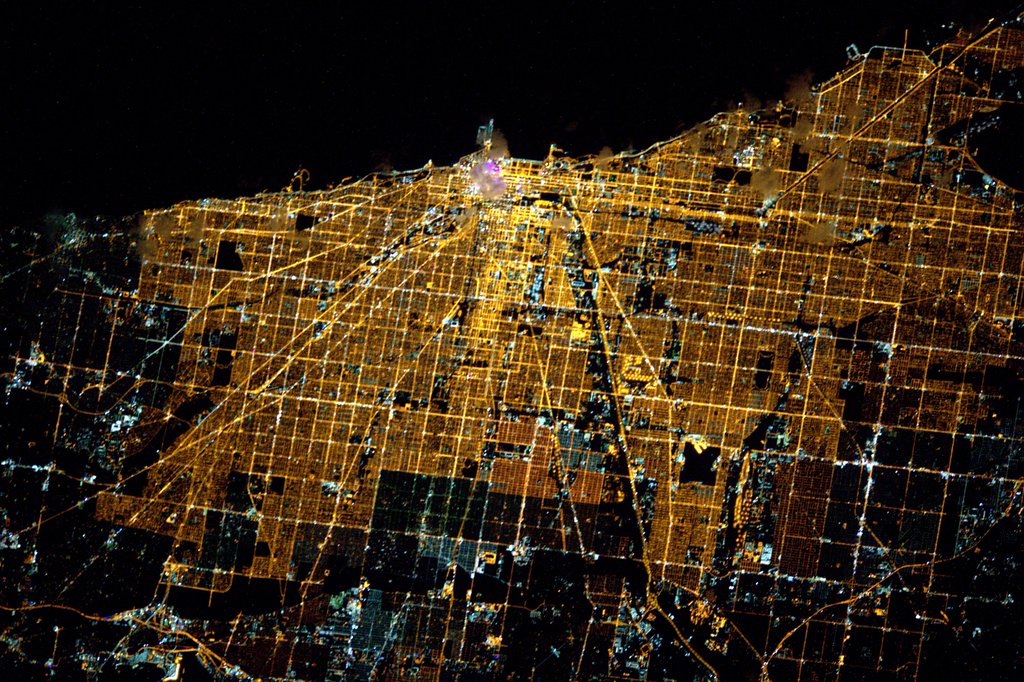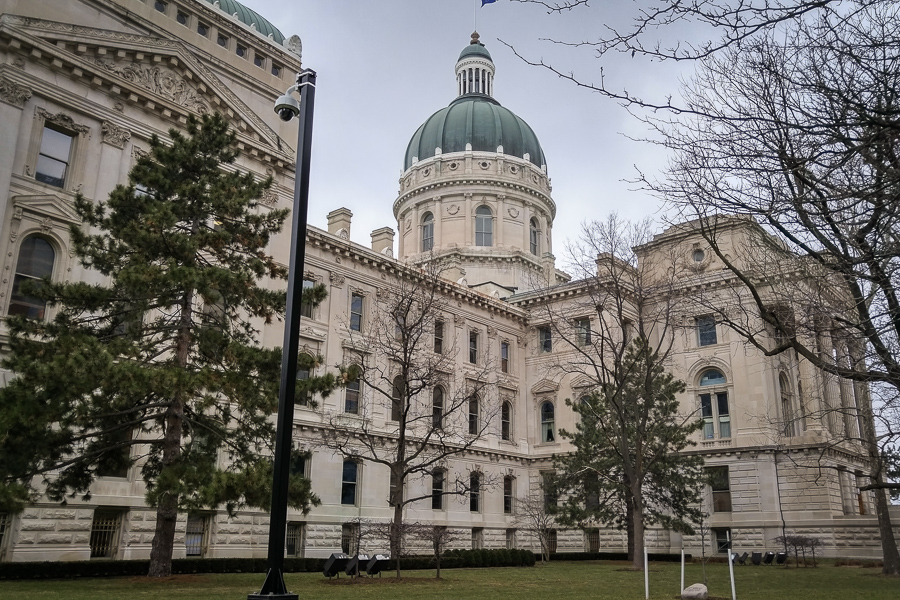Engineer Jeff Speck is dismayed that his home town, Lowell, Mass., is planning to replace an unattractive and un-walkable street with an equally-un-walkable design:
Imagine my surprise, then, when I came across an article earlier this month about the city’s plans for its southern gateway, the Lord Overpass. This site is particularly important to Lowell, being an area of major redevelopment as well as the key link from the train station (at right in the image below) to downtown (beyond the canal to the left). This collection of streets—a squared traffic circle floating above a highway—is due for reconstruction, and the city came up with the smart idea of putting the depressed highway back up at grade to create more of an urban boulevard condition.
So, let’s zoom in and describe what we see:
- Four lanes dedicated to motion straight through, just like the now-submerged highway;
- Three lanes dedicated to turning motions, two of which swoop around the edges in great curves;
- Two dedicated bus lanes, each about 17 feet wide, curb-to-curb. (A bus is 8 1/2 feet wide, so perhaps the goal is to squeeze two past each other?);
- Bike lanes that are partly protected, partly unprotected, and partly merged into the bus lanes;
- A collection of treeless concrete wedges, medians, and “pork chops” directing the flow of vehicles;
- No parallel parking on either the main road or any of the roads intersecting it; and
- Green swales lining the streets, resulting in set-back properties to the one side and open space to the other. (Note that the open space at the bottom of the drawing is too shallow to put a building on.)
The engineering drawings are horrifying. As Speck says, to the engineering firm Lowell hired, everything looks like a nail.
I'm in Bend, Ore., today, doing nothing of value (except blogging and photographing). I'll have a few photos tomorrow or Monday. My goal for the next several hours is to get 25,000 steps in this perfect weather. (I have sunscreen.)
Because no one has actually cleaned up a database of IP address geocodes, a Kansas farmer is getting blamed for all manner of bad behavior on the Internet:
As any geography nerd knows, the precise center of the United States is in northern Kansas, near the Nebraska border. Technically, the latitudinal and longitudinal coordinates of the center spot are 39°50′N 98°35′W. In digital maps, that number is an ugly one: 39.8333333,-98.585522. So back in 2002, when MaxMind was first choosing the default point on its digital map for the center of the U.S., it decided to clean up the measurements and go with a simpler, nearby latitude and longitude: 38°N 97°W or 38.0000,-97.0000.
As a result, for the last 14 years, every time MaxMind’s database has been queried about the location of an IP address in the United States it can’t identify, it has spit out the default location of a spot two hours away from the geographic center of the country. This happens a lot: 5,000 companies rely on MaxMind’s IP mapping information, and in all, there are now over 600 million IP addresses associated with that default coordinate. If any of those IP addresses are used by a scammer, or a computer thief, or a suicidal person contacting a help line, MaxMind’s database places them at the same spot: 38.0000,-97.0000.
Which happens to be in the front yard of Joyce Taylor’s house.
And, of course, since most people don't understand (a) default data, (b) data errors, or (c) how anything at all actually works, default IP mapping by MaxMind and other companies (including Google and Facebook) has resulted in people behaving stupidly all over the U.S.
Pro tip: Never live near a major data center.
Via Chicagoist, astronaut Tim Kopra snapped this from aboard the International Space Station earlier this week:

The city's borders show up brilliantly because unlike most of the surrounding suburbs, Chicago uses sodium-vapor lamps, which glow yellow-orange. But that's changing (including right in my own alley):
The Chicago Infrastructure Trust will replace the city's 348,500 outdoor lights with energy-efficient LED technology, according to a statement from City Hall. The Smart Lighting Project is aimed at making the city's lighting more environmentally-friendly and save money.
The LED lights would be significantly more efficient than the current sodium-vapor lights and would produce the same amount of light while using a fraction of the electricity, according to TimeOut Chicago. However, the new lights will produce a white light instead of the famous orange glow.
I have say, the LEDs are much more pleasant than the old lights, and they use just a fraction of the energy. But someday the city's outline won't be as visible from above.
I've been running around all day and only have a couple of minutes to list some things I've read on my phone while running around. All day.
There were a few other things in there, but these were the ones I paid most attention to.
In between four rehearsals and two performances this week (Monday through Sunday), I'm taking tonight off. So while I have a minute or two between helping new developers understand some old code, I'm jotting down this list of things that looked particularly appealing when they came up on RSS feeds:
OK, the new devs are testing something...and more on that later.
Yesterday's 17.2°C temperature at O'Hare was the warmest since it was 17.8°C on November 15th. It might not get warmer than that, but who cares, because it that's plenty warm for early March. 17.8°C is Chicago's normal temperature for April 29th; the normal for March 8th is 6.1°C.
That's the good news. The better news is that working from home means Parker is working napping from home as well. And we just got back from an 80-minute, 8.1-km walk, his longest in (no surprise) even more months.
Now the bad news. We were walking from the car dealership where they are figuring out how much I'm to pay them later this week. My car has a couple of "minor" symptoms including a damaged tire (thanks, Chicago!), but it's a 7-year-old BMW. So anything that would cost $100 to fix on a Corolla will cost me $200. Can't wait for the call...
I do have some work to do today—more on that this afternoon. But I'm already at 11,000 steps, with a goal of 30,000 for the day. I've only hit that number once, last April 26th. There's a lot of day ahead of me, and it's 9,000 steps back to the car dealership. Stay tuned.
Update, 11:26: The 11am temperature at O'Hare was 19°C, the highest reading since November 5th. If we hit 23°C we'll have the warmest day since October 21st.
I've been out of town twice in the last 10 days. First, to New York, where I found this light at the end of a tunnel in Riverside Park:
This weekend I went to Indianapolis for a wedding, and stopped by the Indiana State Capitol:
That building is home to what may be the stupidest legislative body in the Western world. Don't even get me started.
Wow, a Saturday post. Rare this year, yes?
Tomorrow I'll have photos from New York and Indianapolis, including the latter's monument to stupidity. Check back.
While I'm going through a boring cycle of NuGet updates, unit tests, and inexplicable app-publishing failures related to the above, I'm piling up a crapload of articles to read on my flight tomorrow:
Back to work. At least my build is succeeding now.